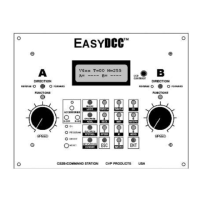117
Maximizing System Performance and Function Key Response
The EasyDCC Command Station is very busy handling all of your layout's locomotives and
turnouts. Extensive testing by us and by customers with large layouts and large groups of
operators allows us to recommend the best of several methods with which you can manage the
overall system performance. Before getting into the various system optimization options, the
following guidelines should be followed since they directly impact the overall performance and
are independent of the option selected.
Use only advanced consists. Large numbers of standard consists will drastically slow system
performance.
Don't use the programming track during group operation. The moment the programming
track is activated, the mainline trains will not receive throttle commands and will continue
operating with the last issued command until the programming task is completed. For some
programming sequences, it can be several 10's of seconds before programming is completed and
throttles and locomotives resume normal operation.
Always set the Command Station's default speed step setting to the desired value. This
insures proper speed step matching for new locomotive addresses. Use the SETUP #STEPS
command.
Setup throttle A and B for no addresses. SETUP A (or B) ENTER. Display will show dashes.
Assign plug-in and wireless throttles to a common and unused address before unplugging or
turning them off. This automatically allows another throttle to gain control without having to
wait for the two minute timeout.
Plug-in throttles will always have the fastest response since they have a hardwired connection
to the command station.
Wireless Throttle System offers several performance otimization settings. In most cases,
performance is a compromise between the number of wireless throttles and the number of
wireless receivers. The best case performance is where each wireless throttle has its own
receiver. The worst case performance is where a single frequency is shared by many wireless
throttles.
Sound Decoders also have inherent delays. As we tested newer decoders, we discovered that
sound decoders have their own delays, especially for horns and whistles. This is done in part to
insure that sound decoders don't inadvertently sound their horn or whistle as a result of dirty track
or dirty wheels. Thus some decoders require a longer than normal press on the F2 key before the
horn actually sounds.
The NMRA-DCC standard is a
relatively slow transmission method.
Common sense says that as more
locomotive addresses and throttles
become active, the time to service each
active address increases. However, there
is a limit beyond which the DCC
standard itself is responsible for the
delays.
The graph shows that there is great
response time when fewer than 15
throttles are in use (one throttle equals
one active address). As more throttles are
added, the F2 response time degrades.
With a maximum number of throttles in
use, the response time is graded as only
fair.
This graph assumes all locomotives are being sent commands continuously which will rarely
occur in actual operation.
3125252015105
Number of Active Addresses/Throttles
Fair Good Great
F2 Response - Worst Case All Addresses Active

